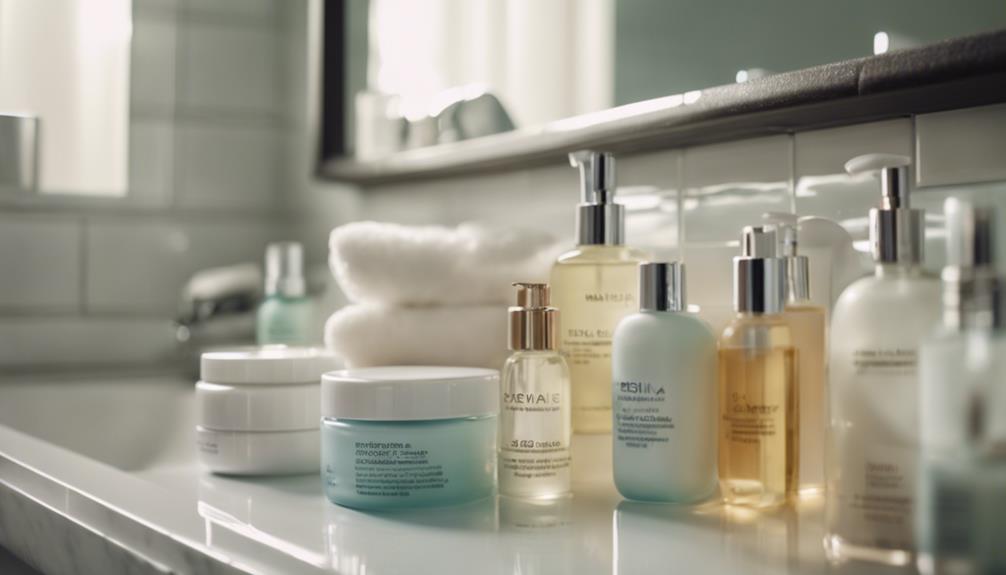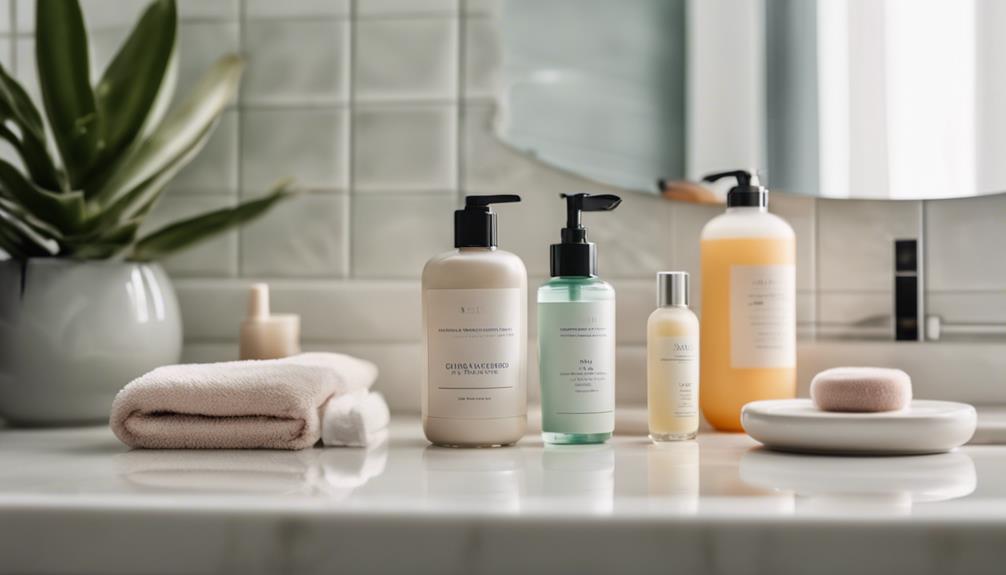Your morning skincare routine focuses on protecting and preparing your skin for the day, using gentle cleansers, hydrating products, antioxidants, and SPF. At night, your routine shifts to repairing and nourishing, incorporating richer treatments like retinoids and oils to support cell renewal. Both routines aim to keep your skin healthy and radiant, but they serve different purposes based on the time of day. Keep exploring to discover how to optimize each step for your skin.
Key Takeaways
- Morning routines focus on cleansing, protecting, and hydrating skin, often including SPF, while night routines emphasize repair and nourishment with richer products.
- Active ingredients like retinoids are typically used at night to support skin renewal, whereas antioxidants and sunscreens are prioritized during the day.
- Morning skincare prepares skin for environmental stressors, while evening routines help repair damage from pollutants and daily stress.
- Proper cleansing is essential before applying targeted treatments or moisturizers in both routines to ensure effectiveness and prevent issues.
- Tailoring products to skin type and season enhances results, with lighter formulations for day and more nourishing options for night.
Key Objectives of Morning and Night Skincare Routines
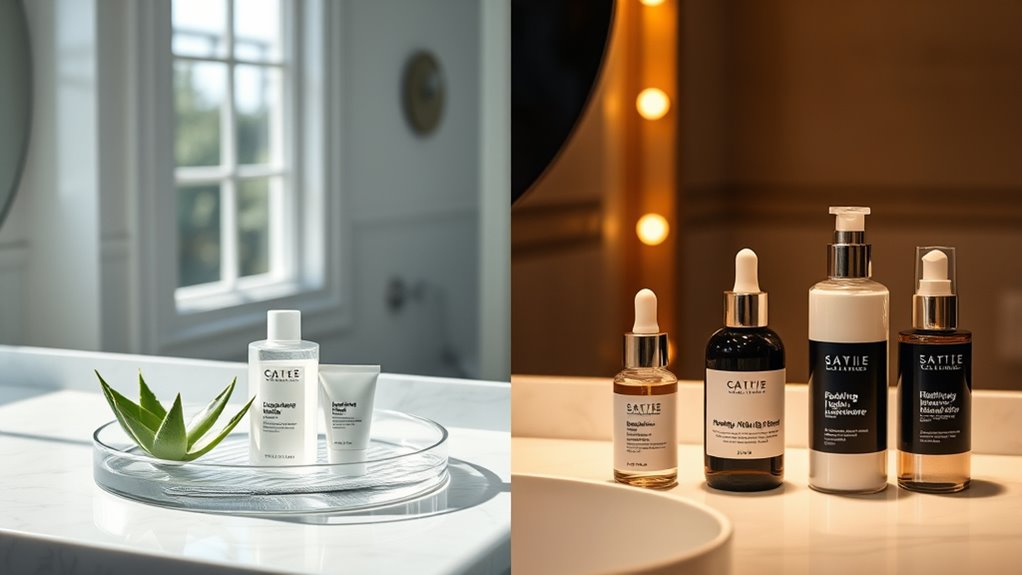
Understanding the key objectives of your morning and night skincare routines helps you achieve healthier, more radiant skin. In the morning, your goal is to protect and prepare your skin for the day ahead. This means cleansing away excess oil, impurities, and sweat accumulated overnight. You also want to hydrate and apply sunscreen to prevent environmental damage. Color accuracy in your skincare products can influence how well you see the true effects of your routine. Ensuring the right skincare ingredients are used during the day can maximize protective benefits. Nighttime routines focus on repair and rejuvenation. After a day of exposure to pollutants and stress, your skin needs cleansing to remove dirt, makeup, and pollutants. This allows your skin to breathe and repair itself. Nighttime is when cell renewal peaks, so your routine should include nourishing products that support this process. Incorporating skincare tools and accessories can enhance the effectiveness of your routine and ensure thorough application. By understanding these objectives, you can tailor your routines to maximize skin health and radiance.
Essential Products for Morning and Evening Use
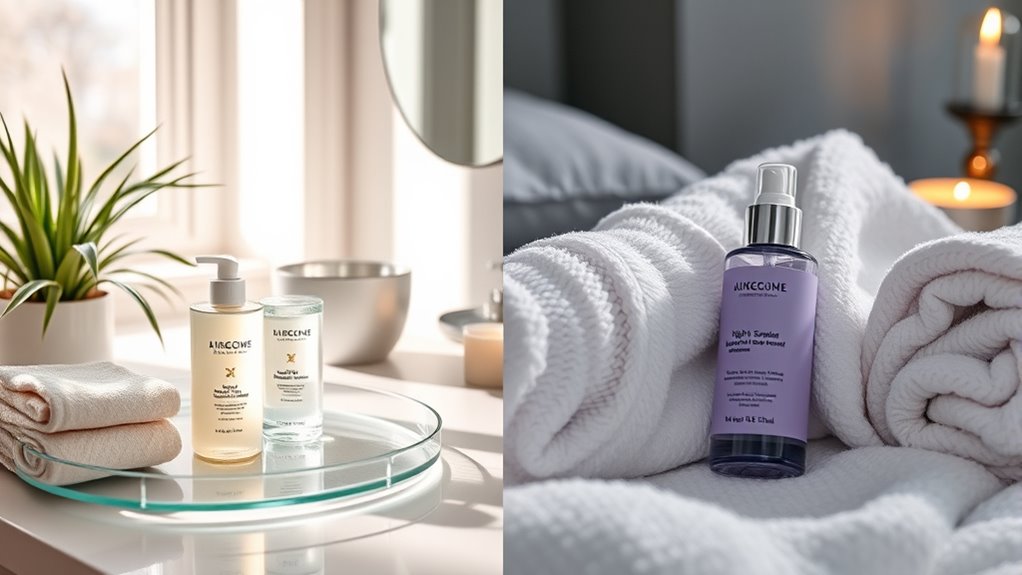
In the morning, hydrating serums help you boost moisture and prepare your skin for the day. At night, repairing treatments work to restore and rejuvenate while you sleep. Knowing which products to use at each time makes your skincare routine more effective. Incorporating proper product placement can also enhance the effectiveness of your routine by ensuring your skincare products are absorbed optimally.
Morning: Hydrating Serums
Hydrating serums are essential for your morning skincare routine because they provide a quick boost of moisture to start your day. They help your skin feel plump, refreshed, and ready to face the day’s challenges. When you apply a lightweight serum, it quickly sinks in, delivering hydration deep into your skin. This can improve elasticity, reduce dullness, and create a smooth canvas for your makeup. Think of it as giving your skin a tall glass of water—fueling your glow. Additionally, selecting products based on your skin type can optimize their effectiveness throughout the day. Incorporating industry trends such as hyaluronic acid or glycerin can further enhance hydration and overall skin health. Using a serum with active ingredients tailored to your skin’s needs can also boost your morning routine’s effectiveness. Moreover, understanding the importance of hydration levels can help you choose the most suitable serum for your skin’s specific needs.
Night: Repairing Treatments
As you finish your morning routine with a hydrating serum, preparing your skin for overnight repair becomes the next step. Nighttime is when your skin works hardest to recover from daily stressors and environmental damage. Incorporate repairing treatments like retinoids, nourishing oils, or targeted serums to support cell renewal and boost collagen production. These products help fade dark spots, smooth fine lines, and restore firmness while you sleep. It’s essential to choose formulations suited for nighttime use—usually richer and more potent.
- Use a retinoid or vitamin A derivative to accelerate cell turnover
- Apply nourishing facial oils to lock in hydration and repair skin barrier
- Opt for soothing ingredients like ceramides or peptides to calm and restore
Step-by-Step Guide to a Morning Skincare Routine
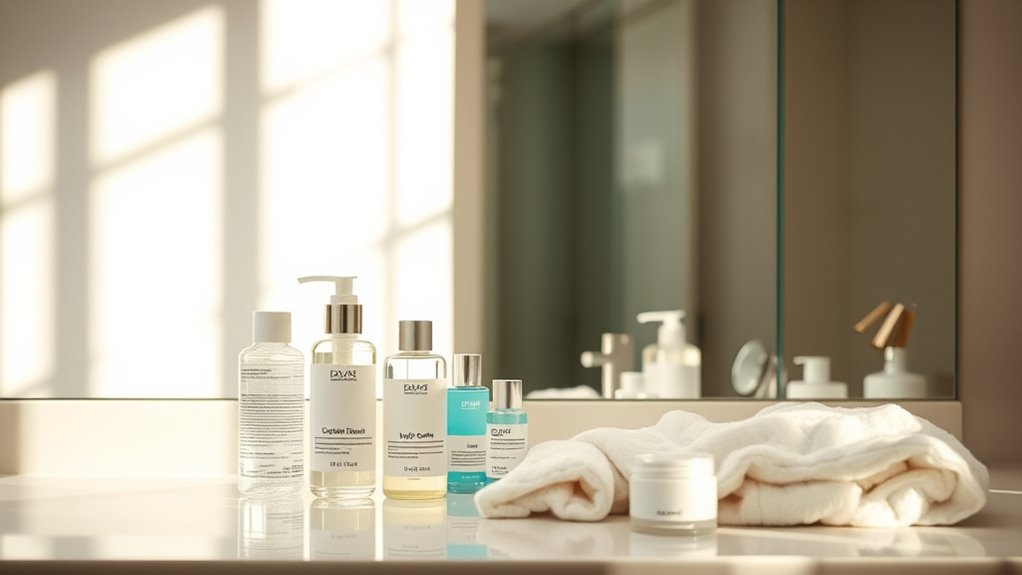
Start your morning routine by cleansing and toning your skin to remove impurities and prep it for the day. Next, apply serums and moisturizer to nourish and protect your skin. Don’t forget to finish with a broad-spectrum sunscreen to shield your skin from harmful UV rays.
Cleansing and Toning
Cleansing and toning are essential first steps in your morning skincare routine, helping to remove dirt, oil, and impurities accumulated overnight. Starting with a gentle cleanser guarantees your skin is clean and fresh, creating a smooth base for the rest of your routine. Follow up with a toner to balance your skin’s pH, tighten pores, and prepare it for moisturizing. Use lukewarm water to rinse thoroughly and pat your skin dry with a soft towel—avoid rubbing. Incorporate a toner suited to your skin type, whether hydrating, exfoliating, or clarifying. This simple process refreshes your skin and sets the tone for the day.
- Choose a cleanser that matches your skin type
- Apply toner with a cotton pad or your fingertips
- Pat your skin dry gently to avoid irritation
Applying Serums and Moisturizer
Applying serums and moisturizer is a essential step that enhances your skin’s appearance and protection for the day. Start by applying a few drops of serum onto clean, dry skin. Gently pat it in, focusing on areas needing extra care, like fine lines or uneven tone. Serums deliver concentrated ingredients that target specific concerns, so use them wisely. Next, take a generous amount of moisturizer and apply it evenly across your face and neck. Use upward, circular motions to boost absorption and stimulate circulation. The moisturizer locks in the serum’s benefits and creates a barrier against environmental stressors. Make sure to cover all areas, including your jawline and behind your ears. This step leaves your skin hydrated, smooth, and ready to face the day.
Sun Protection Measures
After applying your serums and moisturizer, it’s time to shield your skin from the sun’s harmful rays. Sun protection is essential to prevent premature aging, dark spots, and skin cancer. Start with a broad-spectrum sunscreen that offers at least SPF 30. Apply it generously to all exposed areas, including your face, neck, and ears. Reapply every two hours if you’re outdoors or sweating. Don’t forget to reach for sunglasses and a wide-brimmed hat for additional protection. You can also seek shade during peak sun hours, typically between 10 a.m. and 4 p.m. Remember, consistent sun protection keeps your skin healthy and youthful. Incorporate these simple steps into your morning routine to safeguard your skin effectively. Using UV filters in your sunscreen can further enhance protection against sun damage. Additionally, choosing sunscreens with broad-spectrum protection ensures comprehensive defense from both UVA and UVB rays. To maximize your sun safety, understanding the importance of sunscreen reapplication can make a significant difference in your skin’s long-term health.
Step-by-Step Guide to an Evening Skincare Routine
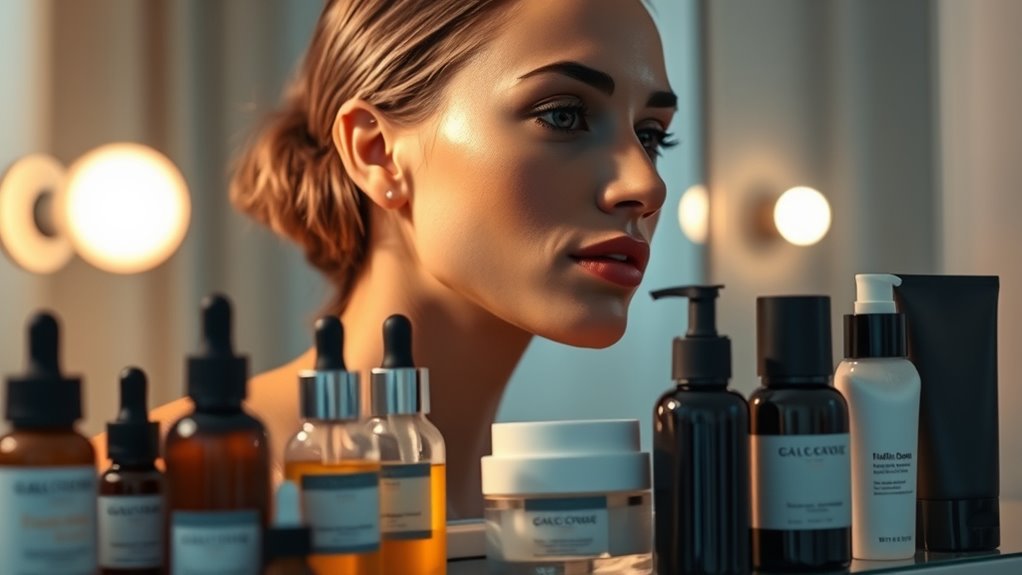
To effectively wind down your day and prepare your skin for overnight repair, following a structured evening skincare routine is essential. Start by removing makeup and dirt with a gentle cleanser suited for your skin type. Next, apply a toner if you use one, to balance your skin’s pH and tighten pores. Follow up with targeted treatments like serums or spot treatments to address specific concerns such as acne or dullness. Then, apply a nourishing eye cream to hydrate the delicate skin around your eyes. Finish with a rich moisturizer or night cream to lock in moisture and support skin renewal while you sleep. Consistency is key, so stick to this routine to promote healthier, more radiant skin over time.
Common Mistakes to Avoid When Switching Between Routines

Switching between morning and night skincare routines without careful consideration can lead to common mistakes that affect your skin’s health. One mistake is using harsh products at the wrong time, like applying heavy creams in the morning that can clog pores or ignoring sunscreen. Another is skipping essential steps when switching routines, such as neglecting to remove makeup at night, which leads to breakouts. Ultimately, mixing incompatible products, like combining active ingredients without guidance, can cause irritation or reduce effectiveness. To avoid these pitfalls, pay attention to the purpose of each routine and tailor your products accordingly. Always cleanse thoroughly, avoid overloading your skin with too many products at once, and be cautious with active ingredients to protect your skin’s balance.
Tips for Customizing Your Routine for Different Skin Types
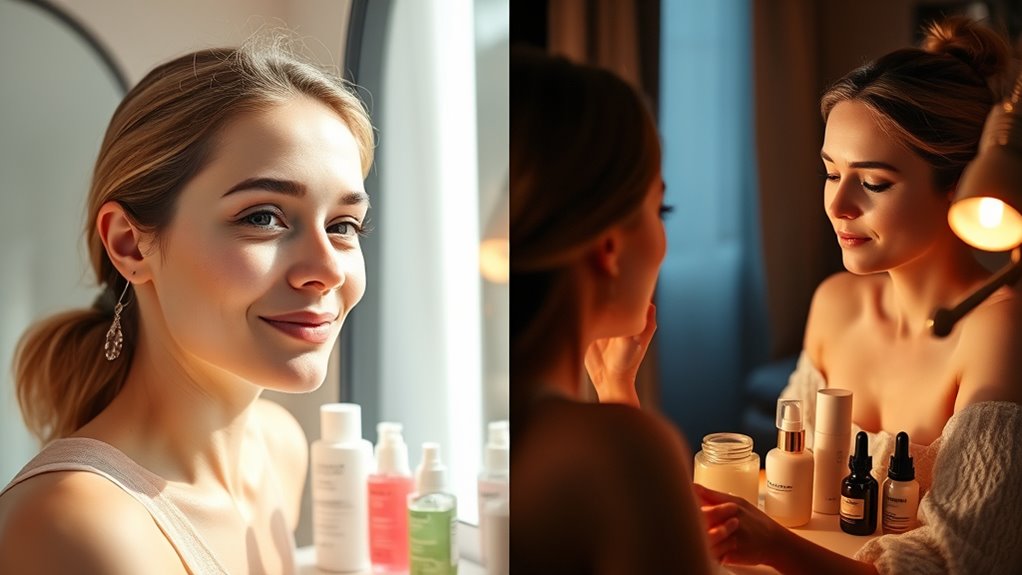
Understanding your skin type is essential for creating an effective skincare routine. If you have oily skin, opt for lightweight, oil-free products that control shine without clogging pores. For dry skin, choose hydrating creams and ingredients like hyaluronic acid to boost moisture. Sensitive skin benefits from gentle, fragrance-free formulas that soothe irritation. If you have combination skin, focus on balancing your skin by using different products on oily and dry areas. Always patch-test new products to avoid reactions. Adjust your routine based on seasonal changes; you might need richer moisturizers in winter or lighter ones in summer. Pay attention to how your skin responds and tweak your routine accordingly. Customizing your skincare guarantees better results and healthier skin tailored specifically for you.
Frequently Asked Questions
Can I Switch My Routine Based on Weather Conditions?
You can definitely switch your skincare routine based on weather conditions. If it’s cold or windy, opt for richer moisturizers and barrier repair products to protect your skin. In hot, humid weather, go for lighter, oil-free formulas to prevent clogged pores. Adjusting your routine helps your skin stay balanced and healthy regardless of the climate. Pay attention to how your skin reacts and tweak your products accordingly.
How Long Should Each Skincare Step Take?
Think of your skincare routine as a well-choreographed dance. Each step should flow smoothly, not rushed or dragged. Typically, cleansing takes about a minute to wash away impurities. Follow with toners and serums, which need around 1-2 minutes each to absorb. Moisturizers and sunscreens should be gently applied, taking another minute. Overall, aim for 10-15 minutes to give each step the attention it deserves, ensuring your skin gets the love it needs.
Are There Specific Products for Sensitive Skin Mornings and Nights?
You might wonder if sensitive skin needs special products at different times. Generally, yes, you should choose gentle, fragrance-free cleansers and moisturizers for both mornings and nights. Look for calming ingredients like aloe or chamomile. In the morning, add a broad-spectrum SPF to protect your skin from UV rays. At night, opt for nourishing, hydrating products without harsh chemicals. This routine helps keep your skin calm and healthy around the clock.
Is Sunscreen Necessary During Nighttime Skincare?
Sunscreen isn’t necessary during your nighttime skincare routine because you’re not exposed to sunlight. At night, your skin repairs itself, so focus on nourishing and hydrating with serums and moisturizers. Wearing sunscreen during the day protects your skin from UV rays, preventing damage and aging. Skip sunscreen at night, and instead, prioritize ingredients like retinol or antioxidants to boost your skin’s recovery and renewal while you sleep.
How Often Should I Update My Skincare Routine?
You should update your skincare routine every few months or whenever your skin’s needs alter. Pay attention to how your skin reacts and adjust products accordingly. If you notice breakouts, dryness, or irritation, it’s time for a change. Seasonal shifts, aging, or new skin concerns also call for routine updates. Regularly reviewing your products keeps your skin healthy and ensures you’re using the most effective treatments.
Conclusion
Think of your skincare routine as the sunrise and sunset of your skin’s day. Morning awakens your glow, while night shields it in restful darkness. By balancing these two, you nurture your skin’s natural rhythm, like a gentle tide that renews and preserves. Embrace each step as a essential stroke in your personal masterpiece, ensuring your skin’s story is one of radiance and resilience—beautifully illuminated from dawn to dusk.



